Performance Management System: Advantages and Disadvantages
VerifiedAdded on 2022/08/22
|5
|813
|22
Report
AI Summary
This report provides an analysis of a performance management system, discussing its advantages and disadvantages within an organizational context. The report highlights the benefits of goal setting, improved communication between employees and managers, and enhanced employee motivation, leading to increased efficiency and productivity. It also addresses potential negative outcomes, such as internal competition, team dysfunction, the time-consuming nature of implementation, and the risk of favoritism. The report emphasizes the importance of understanding these factors for effective system implementation and overall organizational success, supported by references to relevant academic research.
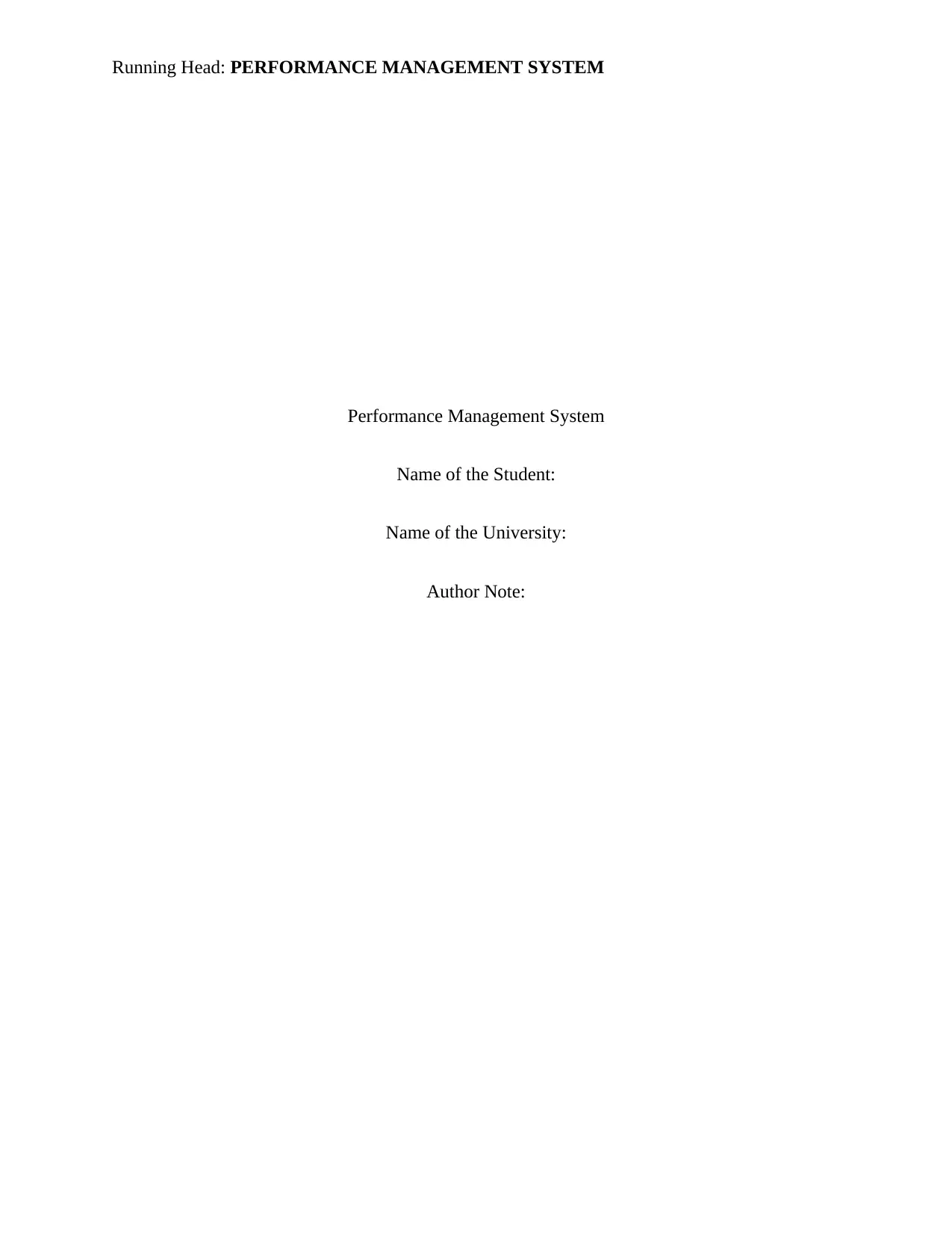
Running Head: PERFORMANCE MANAGEMENT SYSTEM
Performance Management System
Name of the Student:
Name of the University:
Author Note:
Performance Management System
Name of the Student:
Name of the University:
Author Note:
Paraphrase This Document
Need a fresh take? Get an instant paraphrase of this document with our AI Paraphraser
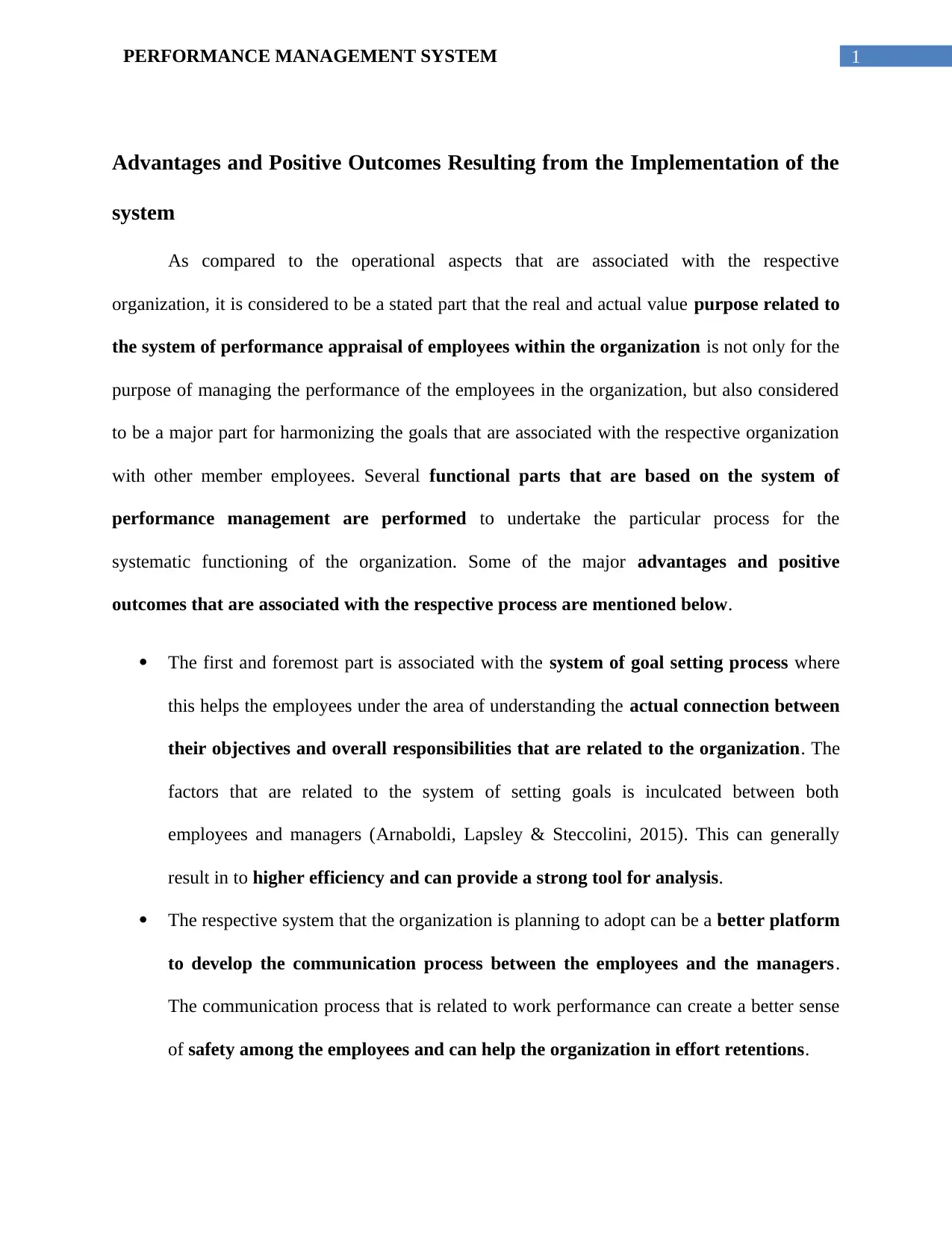
1PERFORMANCE MANAGEMENT SYSTEM
Advantages and Positive Outcomes Resulting from the Implementation of the
system
As compared to the operational aspects that are associated with the respective
organization, it is considered to be a stated part that the real and actual value purpose related to
the system of performance appraisal of employees within the organization is not only for the
purpose of managing the performance of the employees in the organization, but also considered
to be a major part for harmonizing the goals that are associated with the respective organization
with other member employees. Several functional parts that are based on the system of
performance management are performed to undertake the particular process for the
systematic functioning of the organization. Some of the major advantages and positive
outcomes that are associated with the respective process are mentioned below.
The first and foremost part is associated with the system of goal setting process where
this helps the employees under the area of understanding the actual connection between
their objectives and overall responsibilities that are related to the organization. The
factors that are related to the system of setting goals is inculcated between both
employees and managers (Arnaboldi, Lapsley & Steccolini, 2015). This can generally
result in to higher efficiency and can provide a strong tool for analysis.
The respective system that the organization is planning to adopt can be a better platform
to develop the communication process between the employees and the managers.
The communication process that is related to work performance can create a better sense
of safety among the employees and can help the organization in effort retentions.
Advantages and Positive Outcomes Resulting from the Implementation of the
system
As compared to the operational aspects that are associated with the respective
organization, it is considered to be a stated part that the real and actual value purpose related to
the system of performance appraisal of employees within the organization is not only for the
purpose of managing the performance of the employees in the organization, but also considered
to be a major part for harmonizing the goals that are associated with the respective organization
with other member employees. Several functional parts that are based on the system of
performance management are performed to undertake the particular process for the
systematic functioning of the organization. Some of the major advantages and positive
outcomes that are associated with the respective process are mentioned below.
The first and foremost part is associated with the system of goal setting process where
this helps the employees under the area of understanding the actual connection between
their objectives and overall responsibilities that are related to the organization. The
factors that are related to the system of setting goals is inculcated between both
employees and managers (Arnaboldi, Lapsley & Steccolini, 2015). This can generally
result in to higher efficiency and can provide a strong tool for analysis.
The respective system that the organization is planning to adopt can be a better platform
to develop the communication process between the employees and the managers.
The communication process that is related to work performance can create a better sense
of safety among the employees and can help the organization in effort retentions.
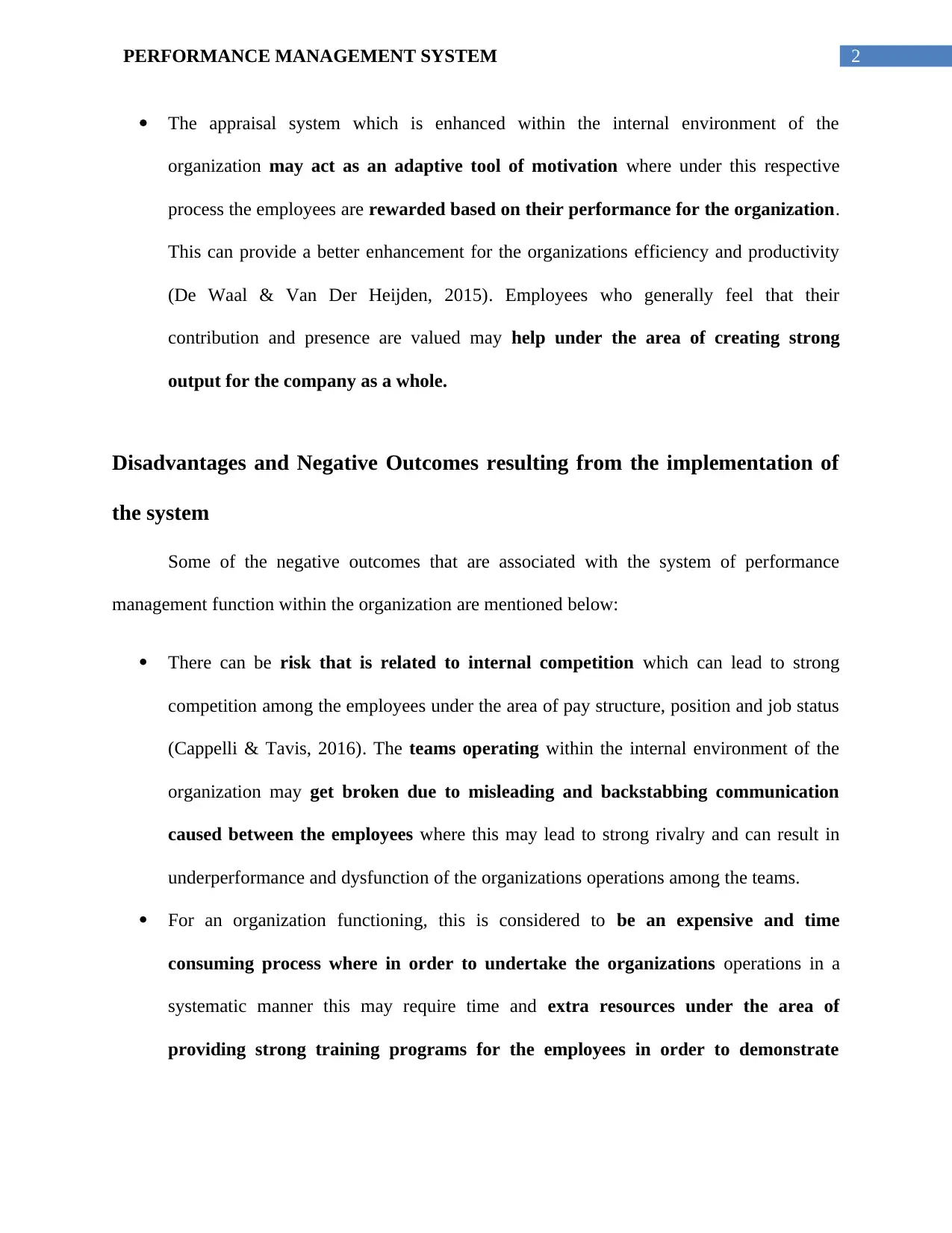
2PERFORMANCE MANAGEMENT SYSTEM
The appraisal system which is enhanced within the internal environment of the
organization may act as an adaptive tool of motivation where under this respective
process the employees are rewarded based on their performance for the organization.
This can provide a better enhancement for the organizations efficiency and productivity
(De Waal & Van Der Heijden, 2015). Employees who generally feel that their
contribution and presence are valued may help under the area of creating strong
output for the company as a whole.
Disadvantages and Negative Outcomes resulting from the implementation of
the system
Some of the negative outcomes that are associated with the system of performance
management function within the organization are mentioned below:
There can be risk that is related to internal competition which can lead to strong
competition among the employees under the area of pay structure, position and job status
(Cappelli & Tavis, 2016). The teams operating within the internal environment of the
organization may get broken due to misleading and backstabbing communication
caused between the employees where this may lead to strong rivalry and can result in
underperformance and dysfunction of the organizations operations among the teams.
For an organization functioning, this is considered to be an expensive and time
consuming process where in order to undertake the organizations operations in a
systematic manner this may require time and extra resources under the area of
providing strong training programs for the employees in order to demonstrate
The appraisal system which is enhanced within the internal environment of the
organization may act as an adaptive tool of motivation where under this respective
process the employees are rewarded based on their performance for the organization.
This can provide a better enhancement for the organizations efficiency and productivity
(De Waal & Van Der Heijden, 2015). Employees who generally feel that their
contribution and presence are valued may help under the area of creating strong
output for the company as a whole.
Disadvantages and Negative Outcomes resulting from the implementation of
the system
Some of the negative outcomes that are associated with the system of performance
management function within the organization are mentioned below:
There can be risk that is related to internal competition which can lead to strong
competition among the employees under the area of pay structure, position and job status
(Cappelli & Tavis, 2016). The teams operating within the internal environment of the
organization may get broken due to misleading and backstabbing communication
caused between the employees where this may lead to strong rivalry and can result in
underperformance and dysfunction of the organizations operations among the teams.
For an organization functioning, this is considered to be an expensive and time
consuming process where in order to undertake the organizations operations in a
systematic manner this may require time and extra resources under the area of
providing strong training programs for the employees in order to demonstrate
⊘ This is a preview!⊘
Do you want full access?
Subscribe today to unlock all pages.

Trusted by 1+ million students worldwide
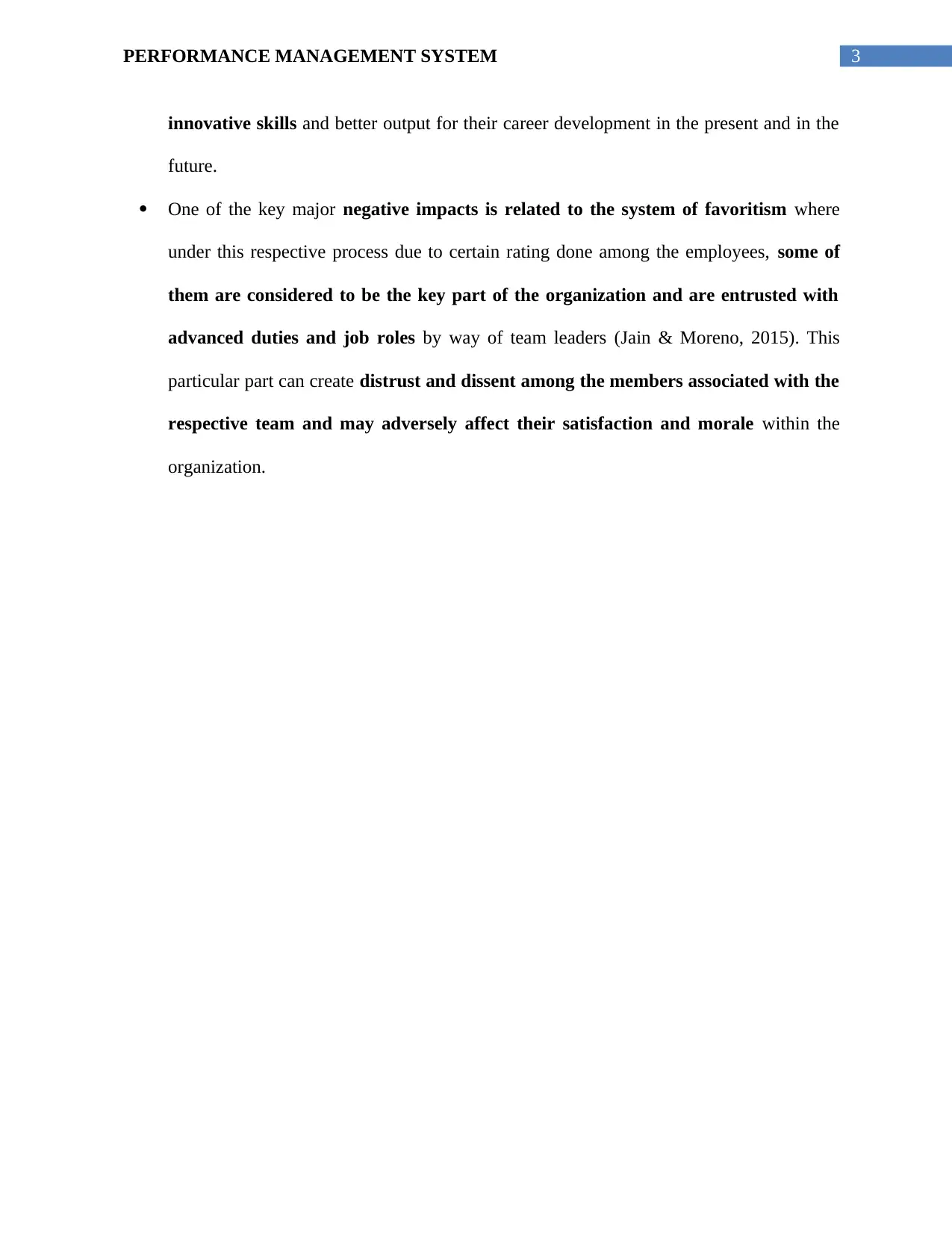
3PERFORMANCE MANAGEMENT SYSTEM
innovative skills and better output for their career development in the present and in the
future.
One of the key major negative impacts is related to the system of favoritism where
under this respective process due to certain rating done among the employees, some of
them are considered to be the key part of the organization and are entrusted with
advanced duties and job roles by way of team leaders (Jain & Moreno, 2015). This
particular part can create distrust and dissent among the members associated with the
respective team and may adversely affect their satisfaction and morale within the
organization.
innovative skills and better output for their career development in the present and in the
future.
One of the key major negative impacts is related to the system of favoritism where
under this respective process due to certain rating done among the employees, some of
them are considered to be the key part of the organization and are entrusted with
advanced duties and job roles by way of team leaders (Jain & Moreno, 2015). This
particular part can create distrust and dissent among the members associated with the
respective team and may adversely affect their satisfaction and morale within the
organization.
Paraphrase This Document
Need a fresh take? Get an instant paraphrase of this document with our AI Paraphraser
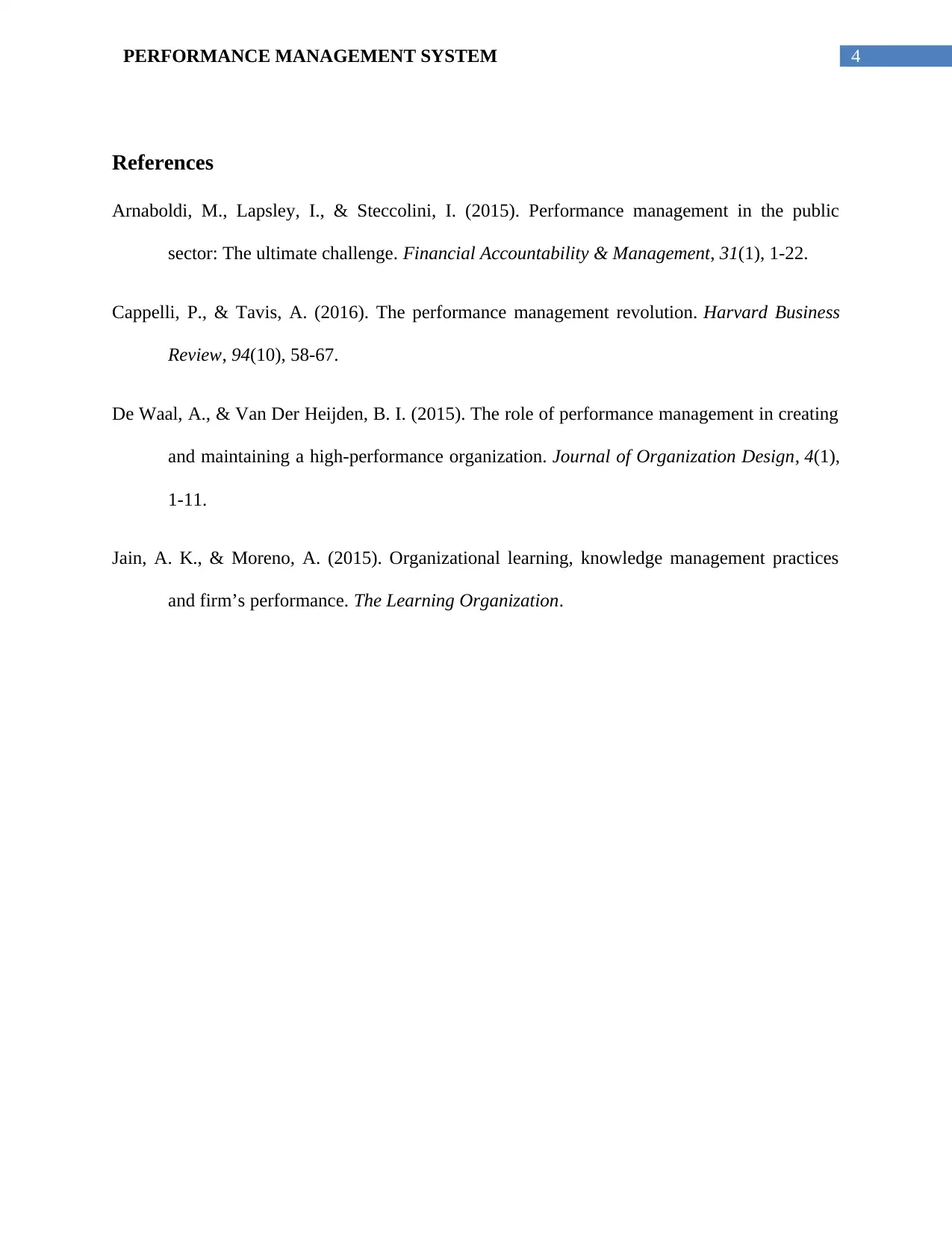
4PERFORMANCE MANAGEMENT SYSTEM
References
Arnaboldi, M., Lapsley, I., & Steccolini, I. (2015). Performance management in the public
sector: The ultimate challenge. Financial Accountability & Management, 31(1), 1-22.
Cappelli, P., & Tavis, A. (2016). The performance management revolution. Harvard Business
Review, 94(10), 58-67.
De Waal, A., & Van Der Heijden, B. I. (2015). The role of performance management in creating
and maintaining a high-performance organization. Journal of Organization Design, 4(1),
1-11.
Jain, A. K., & Moreno, A. (2015). Organizational learning, knowledge management practices
and firm’s performance. The Learning Organization.
References
Arnaboldi, M., Lapsley, I., & Steccolini, I. (2015). Performance management in the public
sector: The ultimate challenge. Financial Accountability & Management, 31(1), 1-22.
Cappelli, P., & Tavis, A. (2016). The performance management revolution. Harvard Business
Review, 94(10), 58-67.
De Waal, A., & Van Der Heijden, B. I. (2015). The role of performance management in creating
and maintaining a high-performance organization. Journal of Organization Design, 4(1),
1-11.
Jain, A. K., & Moreno, A. (2015). Organizational learning, knowledge management practices
and firm’s performance. The Learning Organization.
1 out of 5
Related Documents
Your All-in-One AI-Powered Toolkit for Academic Success.
+13062052269
info@desklib.com
Available 24*7 on WhatsApp / Email
![[object Object]](/_next/static/media/star-bottom.7253800d.svg)
Unlock your academic potential
Copyright © 2020–2025 A2Z Services. All Rights Reserved. Developed and managed by ZUCOL.





